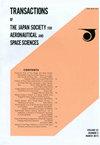放电方式对羽流等离子体区离子能量和等离子体势的影响
IF 0.8
4区 工程技术
Q4 ENGINEERING, AEROSPACE
Transactions of the Japan Society for Aeronautical and Space Sciences
Pub Date : 2022-01-01
DOI:10.2322/tjsass.65.1
引用次数: 1
摘要
本文研究了带辐射加热器的lab6空心阴极在斑点和羽流模式下的离子能量角分布及其与等离子体参数的关系。测量使用延迟电位分析仪(RPA)和单个朗缪尔探针进行。在不同的等离子体模式下,离子能量分布函数(IEDF)特性在电流密度和质量流率依赖方面表现出不同的趋势。随着电流密度的增大,斑点模式的IEDF峰值电位在16 ~ 23V之间变化;随着质量流量的减小,羽流模式的IEDF峰值电位在16 ~ 32V之间变化。考虑到离子能量的角度依赖性,当观测角度从径向转向轴向时,羽流模式(10A, 10sccm)的IEDF峰值电位从29 v增加到40V,斑模式(20A, 30sccm)的IEDF峰值电位从16 v略微增加到18V。探针测量分析表明,IEDF峰值能量与等离子体势相同或超过等离子体势,并与电子温度空间分布有定性的相关性。本文章由计算机程序翻译,如有差异,请以英文原文为准。
The Effect of Discharge Mode on Ion Energy and Plasma Potential in the Plume Plasma Region
The ion energy angle distribution and its relationship to plasma parameters for spot and plume modes are elucidated for a LaB 6 hollow cathode with a radiative heater. Measurements were conducted using a retarding potential analyzer (RPA) and a single Langmuir probe. The ion energy distribution function (IEDF) characteristics showed di ff erent tendencies in the current density and mass fl ow-rate dependence under di ff erent plasma modes. The IEDF peak potential for the spot mode varied from 16 to 23V with increasing current density, and the IEDF peak potential for the plume mode varied from 16 to 32V with decreasing mass fl ow rate. Considering angle dependency of ion energy, when the observation angle was changed from the radial direction to the axial direction, the IEDF peak potential increased from 29 to 40V for the plume mode (10A, 10sccm) and increased slightly from 16 to 18V for the spot mode (20A, 30sccm). The probe measurement analysis revealed that the IEDF peak energies are the same as, or exceed, the plasma potential and have a qualitative correlation with the electron temperature spatial distribution.
求助全文
通过发布文献求助,成功后即可免费获取论文全文。
去求助
来源期刊
CiteScore
1.80
自引率
0.00%
发文量
18
审稿时长
>12 weeks
期刊介绍:
Information not localized

 求助内容:
求助内容: 应助结果提醒方式:
应助结果提醒方式:


